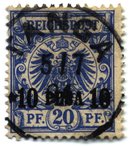Overprint
|
|
An overprint is the addition of text (and sometimes graphics) to the face of a postage stamp after it has been printed. Overprints have been used for many purposes over the years. They have been used as surcharges, commemorations, and control marks.
A surcharge is an overprint that alters or confirms the face value of the stamp. These are commonly used when needed types of stamp are unavailable, whether because new shipments are delayed, because circumstances have changed too quickly to get appropriate new stamps, or simply to use up existing stamps.
Stamp_RU_1922_7500r-500px.jpg
One famous example of surcharging came in the German hyperinflation of 1921-1923. Stamps in the 10-20 pfennig range were no longer useful for paying postage (hundreds would have been required on a normal letter), so at first the government overprinted existing stamps with values up to 10 marks while it was designing new ones, but by 1923 even its printed stamps ranging up to 75,000 marks became useless and had to be surcharged with higher values, up to 2,000,000 marks and then a round with values up to 10,000,000,000 marks (10 billion) before the financial system was reset.

Many countries have used surcharges when converting to new currencies, for example in many Commonwealth countries chose to convert to decimal currency in the late 1960s.
Countries with political instability have frequently had to resort to surcharges because the existing stocks were exhausted and there was no one in charge to order more. In many cases, countries have resorted to overprinting revenue stamps, telegraph stamps, and seemingly anything else they could find that was perforated and gummed - and, in the worst case - stamps that had been previously surcharged.
Stamp_Allenstein_1920_5pf.jpg
Occasionally surcharges have been applied by individual postmasters, especially those in the remotest locations and in the early days of stamps, but because of the possibilities for abuse, this is rarely approved by the national government.
GB_World_Cup_Overprint_Stamp.jpg
Overprints have also been used as commemoratives, as a lower-cost alternative to designing and issuing special stamps. The United States, which historically has issued very few overprints, did this in 1928 for issues commemorating Molly Pitcher and the discovery of Hawaii. A special subcategory is overprinting on sports-related stamps in events such as the Olympics. For example, on April 8, 1998 Guyana issued a set of 32 stamps showing team pictures of all the participants in that year's World Cup championships; on August 20, after the tournament, eight of these were reissued with an overprint announcing France as the winner. This practice is frowned upon by many philatelists. An unfortunately common use of commemorative overprints has been due to revolution; the overprint may obscure or even blot out the previous ruler's head, but invariably proclaims the new regime, frequently with the date of its takeover.
Batumi-overprint.jpg
A more obscure use of overprints has been as control devices to deal with theft. In the 19th century Mexico was plagued by theft of stamps on their way to remote post offices, so every stamp was overprinted with the town name and a number. The United States used this strategy to deal with thefts in Kansas and Nebraska in 1929, overprinting the common stamps of the time with "Kans." and "Nebr." (surviving examples are scarce and prized, the 10c priced at over $100 in 2000).
Despite their temporary and expedient nature, many overprints were produced by the millions, and thus readily available to collectors today. Others are rare and desirable, but all too easy to fake by printing on a copy of the original stamps, and expert authentication is mandatory for valuable overprints.
British stamps are encountered with the word SPECIMEN or CANCELLED applied as an overprint. These were usually applied in black, but other colours are known. These overprints were applied either by the printers as colour standards for matching later printings or by the authorities, (at somerset House), as reference copies or on examples which were being sent to other members of the UPU, (Universal Postal Union). In addition to this booklet panes were cancelled by the use of a punched hole applied by a ticket punch. This was applied by folding the stamps and punching across the fold in addition to the word CANCELLED. These were used in booklets sent out to companies which had advertising within the booklets, so that they could see the finished results but were unable to use the stamp.
In 1930 the British Post Office set up the Post Office Training Schools. These were designed to ensure that staff in all the different offices worked in a standard manner. For these training courses, stamps, as well as other items in general use by the Post Office at the given time, were overprinted in various ways. The most common of these is vertical black bars applied to the face of the stamps in use at the time. These were applied to stop the theft of stamps, as they would be unusable, as well as to save on the problem of having to account for the items in the normal manner. The overprint SCHOOL SPECIMEN has also been applied to stamps, but is more commonly found on items of postal stationery and form, as is FOR TRAINING PURPOSES ONLY in three lines.
Overprints have occasionally been used on currency such as the overprints found on Haitian Gourdes at the end of the Baby Doc Duvalier regime. The overprint consisted of a red circle with a slash across it with the date of the end of the Duvalier regime—February 7, 1986—printed below in red. The overprint was placed over the image of Baby Doc and his father the infamous Papa Doc, François Duvalier that was subsequently replaced with images of figures from the history of the Haitian Republic.
Overprints applied by an entity other than an official stamp-issuing entity are called "private overprints."fr:Surcharge de:Aufdruck

